Home > About Us > Sustainability Management > Sustainability Report > Sustainability Report 2012 > Cooperation with the Local Community
 Cooperation with the Local Community
Cooperation with the Local Community
The Kobe Steel Group takes a cooperative approach on environmental issues with society. We are committed to biodiversity and are constantly working to make a difference in local communities.
Biodiversity Initiatives
![]()
Initiatives at our locations
![]()
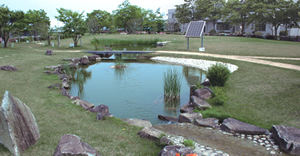
(Kobe Steel)
As well as using fewer substances that have an environmental impact on the air or water, we try to create habitable environments for insects and other small creatures at each of our locations, by setting aside green belt areas for instance, or creating biotopes.
We set up a biotope on the grounds of Kobe Corporate Research Laboratories in 2005 to mark the company's 100th anniversary. We continue to plant trees on the site, including species that produce food for wild birds. As well as providing a space for employees to relax, the biotope has turned our laboratories into a far greener facility.
Initiatives at Nadahama Science Square
![]()
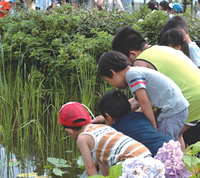
We have also created a biotope at Kobe Steel's community exchange facility Nadahama Science Square (Nada Ward, Kobe), and are working to create a thriving natural environment, home to endangered species such as the Golden Venus Chub (freshwater fish) and Yellow Bladderwort (floating plant).
In 2011, we planted hydrophytic plants – plants that grow well in damp areas – such as White Egret Orchid and Spoon-Leaf Sundew, and seaside plants such as Sea Pea and Beach Morning Glory. We will continue to improve environmental conditions within the biotope in the future, so that even more plants and living creatures can make it their home.
We also organize Nature Classroom activities at Nadahama Science Square, to provide a setting in which children can learn about the environment based on the biotope's living organisms and ecosystem.
Nadahama Science Square has been certified as one of "100 Corporate Greenspaces Helping to Preserve Biodiversity", a nationwide scheme organized by the Urban Green Space Development Foundation (now the Organization for Landscape and Urban Green Infrastructure) to coincide with COP10 in 2010.
 Example initiatives at group companies
Example initiatives at group companies
| Company/location | Details of activities |
|---|---|
| Nippon Koshuha Steel Co., Ltd. Imizu, Toyama |
Regularly looking after trees in green spaces onsite Recycling damaged or fallen branches into wood chips |
| Shinko Engineering Co., Ltd. Ogaki, Gifu |
Planting trees and creating lawns and green blocks as part of onsite environmental improvement work |
| Kobelco Systems Corporation Kobe, Hyogo |
Cleanup activities on Mount Rokko as part of Rokko Clean Hiking activities, forest conservation activities in the foothills of Mount Rokko as part of the Rokko Mountains Greenbelt Development Project, tree planting activities at Iyashi no Mori at Arima Hot Springs, and the Mount Rokko Nature Preservation Center |
| I. H. D. Center Co., Ltd. Kobe, Hyogo |
Covering the car park with grass; planting camphor trees |
Contributing to Local Communities
![]()
Kids Eco-challenge 21
![]()
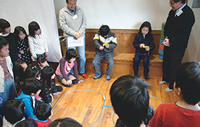
generators
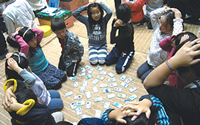
the Japanese card game "Karuta"
As part of our environmental activities in the local community, we are participating in the City of Kobe's Kids Eco-challenge 21. The aim is to teach children, on whose shoulders the future rests, about the importance of environmental activities, while at the same time having fun, playing and doing physical activities.
In fiscal 2011, we went out to Takenodai Children's Center in Kobe's Nishi Ward and organized eco classes for a total of 44 children, teaching them about the importance of electricity and the wonderful ways in which steel is used.
We will continue to lend a hand with environmental education through activities such as these in the future.
Developing children's interest in the environment while having fun
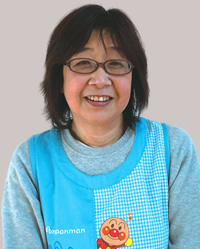
Senior Supervisor
Takenodai Children's House,
City of Kobe
From doing a quiz with the projector and powering trains with wind-up generators to playing an eco version of Karuta, the class was packed full of activities. Seeing things with their own eyes and having fun with hands-on experiences definitely helped the children learn. I was worried that a class about steel might be a bit hard for them to follow, but incorporating so many different ideas really helped develop the children's interest in the environment.
* Eco classes at the children's House are organized as part of the Kobelco Environment Creation Fund.


